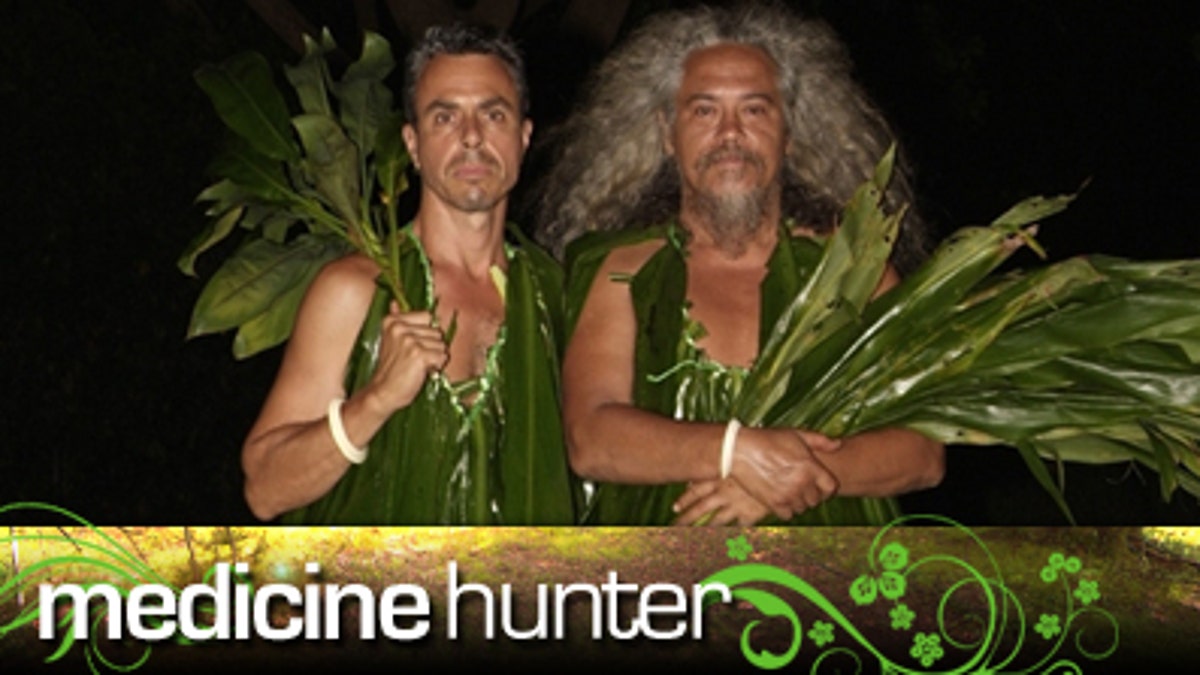
There is something terribly exhilarating to stepping off of perfectly good ground into a burning furnace of uneven volcanic stones, made red-hot by tons of blazing timber underneath. As I stood at the edge of the huge fire pit, all my accumulated knowledge of unbendable physical principles dissolved away. My nerves vibrated like struck piano wire. My abdominal muscles quivered. The radiant heat from the fire baked my legs and chest and face. I took two deep, broiling breaths and stepped into the fire. All thoughts, notions, concepts and ideas ceased in an instant. There was only fire, stone, walking.
My friend Ariipaea Salmon, who I know as Paea, had walked first. As the Tahua, the keeper of the fire, he directed all the preparations leading up to the walk itself, and appealed to the gods and spirits to tame the fire so the rest of us could safely cross the stones.
Behind us, like a sorcerer whose incantations and spells are felt but not seen, lay kava, a Pacific island plant whose psychoactive potion dissolves the cares of a stressed or weary mind, and links the drinker with the spirits of ancient gods.
Kava has been cultivated for over 2,000 years, and originates from Vanuatu. The root of the kava bush is pounded and mixed with water, and then strained and drank. The relaxing effects of kava are immediate. Even as the drinker is swallowing a mouthful of bitter kava, there is a wave of relaxation and tranquility moving through the entire body. In the islands, kava is drunk at its own special time late in the afternoon and evening. In the U.S. and Europe, concentrated extracts of kava are sold in supplement form to allay anxiety and promote a state of alert tranquility.
The history between plants and humans points to a grand closeness. They cause us to perform great feats and labors, carrying them on our backs all around the world. Plants inspire some, and drive others to madness. We eat plants, drink their juices, wear their fibers, scent ourselves with their fragrances, build homes and structures with their materials, adorn our property and bodies with them, employ them to alter mind and mood, are attracted by their beauty or oddness. The influential agents that they are, plants drew me into the sacred native ceremonies of the South Pacific, and into a burning furnace.
In November of 1999, a midnight earthquake at sea generated a gigantic tidal wave, or tsunami, which slammed into Vanuatu’s Pentecost Island. Several villages were destroyed, including Baie Martellie. They were left with nothing. Remarkably, only seven people were killed by the wave, which could have claimed the lives of dozens or even hundreds more natives.
Baie Martellie was where, in 1995, Paea and I first came to know each other. Kava led me there. I was investigating the tranquility-promoting kava, Piper methysticum, for possible extraction and marketing in the U.S. I became friendly with many of the kava growers there, and spent happy times walking with them in the jungle, preparing and drinking kava, and participating in their village life. When Paea informed me that the firewalk would help to raise relief funds for our friends in Baie Martellie, I had no choice but to go and walk.
My first time walking across the twelve foot width of the fire, I burned a spot on the arch of my right foot. I was not willing to let that be my only firewalking experience. Three subsequent times across the same stones, I walked without mishap. When I lined up with Paea and the Pentecost island villagers, we walked the full length of the fifty foot pit safely. The glowing stones were hot enough to fry a steak in seconds. Flames licked up between the rocks. The uneven footing would have made walking precarious without a fire. In the roasting heat of the pit, where forty tons of timber burned beneath fifty tons of volcanic stones, we should have been immolated. Yet we passed through the burning furnace safely.
I do not recommend that, inspired by this article, you burn a bunch of flammable materials and walk on them.
Please, only firewalk in the company of a highly trained and very experienced leader, if at all.
The effect of firewalking is quite powerful. After walking through the roaring furnace, I felt brilliantly alert, as though every cell of my being had been cleansed. For about a month after, I saw the fire pit in my mind when I lay down at night. Firewalking provided me with tremendous inspiration, and a sense of connectedness to the raw powers of nature. Also, as a result of firewalking with various natives, we developed a bond forged by that experience. We were friends, allies, firewalkers.
On March 20, 2011, Paea died at his home on Santo island in Vanuatu, South Pacific. He died of an apparent heart attack after suffering from cardiovascular disease for several years. He was 57 years old. With Paea will also pass many myths and legends, traditional plant knowledge, and a noble bearing that suggested another time.
Note: The experiences and views expressed in this column are not those of FoxNews.com or Newscorp. Fox News does not endorse firewalking at home or without the presence of a professional.
Chris Kilham is a medicine hunter who researches natural remedies all over the world, from the Amazon to Siberia. He teaches ethnobotany at the University of Massachusetts Amherst, where he is Explorer In Residence. Chris advises herbal, cosmetic and pharmaceutical companies and is a regular guest on radio and TV programs worldwide. His field research is largely sponsored by Naturex of Avignon, France. Read more at www.MedicineHunter.com




















